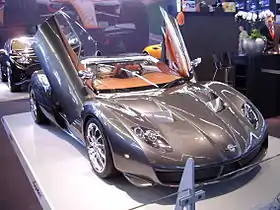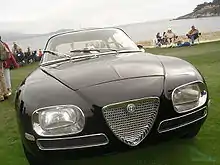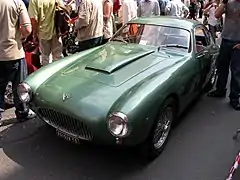Zagato
Zagato is an independent coachbuilding company and total design centre located northwest of Milan in Terrazzano, a small village near Rho, Lombardy, Italy. The company's premises occupy an area of 23,000 square metres (250,000 sq ft), 11,000 of which are covered.
 | |
| Type | Società a responsabilità limitata |
|---|---|
| Industry | Automotive |
| Founded | Milan, Italy (1919) |
| Founder | Ugo Zagato |
| Headquarters | , |
Area served | Worldwide |
Key people | Andrea Zagato, CEO |
| Services | Automotive design |
| Website | www |
History
The 1910s: Aeronautics
Ugo Zagato (born in Gavello, near Rovigo, on June 25, 1890) began his coachbuilding career in 1919 when he left Officine Aeronautiche Pomilio to set up his own business in Milan. This was: “the construction and repair of bodies for automobiles and airplanes”. He did so with the intent of transferring sophisticated constructional techniques that combined lightness with strength from the aeronautics to the automotive sector. Cars of the time were still bulky and heavy: Ugo Zagato conceived them as lightweight structures, with a frame in sheet aluminium similar to an aircraft fuselage. This change in direction came to represent a fundamental chapter in the history of taste and saw, in Europe, the adoption of the concept of functionalism applied to automotive design.
The 1920s: Classic models
During the 20s Zagato concentrated on racing cars. At the beginning of the decade he was asked by Alfa Romeo to dress some Alfa Romeo G1, RL and RM. But in 1925 Vittorio Jano, Alfa Romeo’s Chief Engineer, asked him to create a body for the Alfa 6C 1500, the Alfa Romeo P2’s heir, which should belight and fast. Zagato, using his Aeronautics culture, succeeded in creating a sleek and light body for the car, which scored a 2nd place OA at the 1927 Mille Miglia and it won the 1928 edition. The 6C 1500 technical qualities were improved also on the Alfa Romeo 6C 1750, which was introduced in 1927. It was bodied in several versions (Turismo, Sport or Granturismo, Super Sport or Gran Sport) and achieved overall victories in the Mille Miglia in 1929 (Campari-Ramponi) and 1930 (Tazio Nuvolari, Achille Varzi, Giuseppe Campari and Pietro Ghersi filled the first four places). Enzo Ferrari, who started his career at Alfa Romeo, in 1929 founded Scuderia Ferrari as the official team for race Alfas. Ugo Zagato was his exclusive partner in the thirties. In those years even Ansaldo, Bugatti, Diatto, Fiat, Isotta Fraschini, Lancia, Maserati, OM and even Rolls-Royce were clients of Zagato. [1]
The 1930s: Aerodynamic models
During these decades, Zagato continued building a variety of aerodynamic cars. He adopted inclined windscreens, more aerodynamic headlights, firstly enclosing them in aluminium hemispheres and then incorporating them within the bodywork, convex bootlids and perforated disc wheels that favoured brake cooling. All Alfa Romeo 8Cs received a coach-work from Zagato: Street legal and race - both for Alfa Corse and Scuderia Ferrari - and, starting from January 1932 to the beginning of second world war, the Tipo Zagato were built also by Carrozzeria Brianza (original Zagato address). Bianchi, Fiat, Isotta Fraschini, Lancia, Maserati, OM all experienced the lightweight and aerodynamic Zagato bodies especially for race. The palmares of victories is impressive: 8 Mille Miglia, 4 Targa Florio, 4 Le Mans, 4 Spa Francorchamps OA victories etc. etc. In the 30s Zagato bodied models started to compete and dominate also in different class/categories. Thirty-six Zagato bodied cars were at the start of the 1938 Mille Miglia. One third of the participants.[2]
The 1940s: Panoramic Models
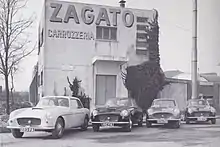
At the outbreak of the Second World War, Ugo Zagato left Milan and flied to Lake Maggiore. On 13 August 1943, a RAF bombing raid destroyed his coachworks in Corso Sempione road. He found new premises at Saronno, alongside the Isotta Fraschini works, on behalf of which he constructed trucks and military vehicles and a futuristic Monterosa. He returned to Milan at the end of the war and re-established his company at Via Giorgini 16, close to the Alfa Romeo historic home at Portello.

He looked for more spacious and more comfortable car greenhouses, which were eventually crystallised in a new type-form characterised by airiness and visibility thanks to large glazed areas made in plexiglass, a new material which replaced the traditional heavy glass. They eventually crystallised in a new type-form characterised by airiness and visibility thanks to large glazed areas made with a new material, Plexiglas, in place of the traditional heavy glass. This “Panoramica” body, as it was called, would mark the rebirth of his coachwork: Alfa Romeo, Fiat, Lancia, Maserati and MG were “dressed” with this innovative body. In 1949 he built a Panoramic body for the Ferrari 166 Mille Miglia, belonging to Antonio Stagnoli - this was the first Ferrari coupé for a client ever. The Panoramic concept was an invention of Luigi Rapi, chief Zagato stylist at that time.[3]
The 1950s: Gran Turismo Models
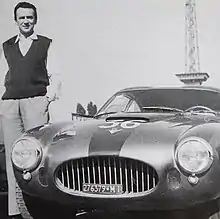
In 1947, as a gift for his graduation at Bocconi University of Milan, Elio Zagato, Ugo’s first-born son, received an open-top sports car based on a Fiat 500 B chassis. This car represented the beginning of his career as a gentleman driver (out of 160 races, Elio earned a place on the podium 83 times) and as a manager of the family company. The birth of the Gran Turismo category, conceived in 1949 by Count Giovanni Lurani, journalist Giovanni Canestrini and Elio himself revolutionised the world of automotive competition: the category comprised cars with sports coachwork and a production chassis or bodyshell. In order to take part in that competitions there should be 30 examples built.
They were, therefore, cars capable of being used on an everyday basis, comfortable and well-finished, yet sufficiently sleek and aerodynamic to race at weekends on the leading circuits. AC, Alfa Romeo, Abarth, Aston Martin, Bristol, Ferrari, Fiat, Fraser Nash, Maserati, Jaguar, Osca, Porsche, Renault wore Zagato GT bodies. In 1955 Elio Zagato scored a memorable victory of the International Granturism Championship at the Avus circuit driving a Fiat 8V GT Zagato.
The 1960s: Fuoriserie models

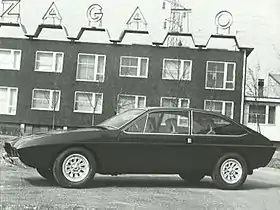
The steady higher demand for special bodies required a passage from a handcraft to an industrially-based organization. Elio Zagato found a larger location at 30 Via Arese in Terrazzano (northwest of Milan), very close to Arese where Alfa Romeo would soon chosen to establish its new plants. In 1960 Ugo Zagato was awarded with the Compasso d’Oro design prize for the design of the Fiat Abarth 1000 Zagato.[4]
In this period the mission of Zagato was to design special bodies to be assembled in series and fitted with mechanical parts and interiors supplied by major constructors. Under the partnership with Alfa Romeo the Giulia SZ, the TZ, TZ2, 2600 SZ, the 1750 4R and the Junior Zagato were born. In partnership with Lancia, Zagato continued the “Sport” series with the Lancia Appia Sport, the Flaminia Sport and Super Sport, the Flavia Sport and Supersport and the Fulvia Sport and Sport Spider. In addition to these some were realized for special customers owners of: Bristol, Fiat, Ford, Lamborghini, Honda, Osca, Rover and Volvo.[5]
The 1970s: Geometric models
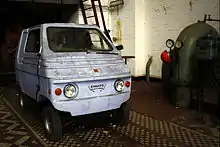
In response to the Oil Crisis and in contrast to the irrational and anti-functionalist trends of the era, Zagato also proposed the production of electric cars. Around 1000 ELCAR Zele were produced and sold in the US. In 1971 a new Ferrari Zagato, called 3Z, came to life thanks to an idea of Luigi Chinetti of Ferrari NART who financed the decidedly angular spider. In the same year it was introduced at the Turin Motor Show and signalled the definitive departure from Alfa SZ, TZ and Lancia Flaminia and Appia’s curvy volumes to embrace the squared volumes of Lancia Fulvia Sport and Alfa Romeo Junior Z. Chinetti himself made a further special order. At that time Zagato started a new project for a different four-seater, mid engined concept which became the Cadillac N.A.R.T. This would be a luxurious, sophisticated, high performance four-seater. The front wheel drive power train of a Cadillac Eldorado was relocated to create a mid-engined layout. Zagato was asked to build the prototype from the drawings and a clay model that was conceived in GM’s studios. A Fiat, based on 132, and named Aster, was bodied as prototype as well as a Volvo GTZ. The Zagato facility in Terrazzano saw also the assembly of Lancia Beta Sport Spider that established Lancia's name in America and Australia and the Bristol 407 convertible, whose design was very similar to the Lancia’s one. [6]
The 1980s: Limited Edition models
While the beginning of the 80’s was characterized by the introduction of a number of Alfa Romeo Concept cars as the Fiat Chicane, the Alfa Romeos rear engine Sprint 6, Zeta 6, Alfetta and Lancia Thema Station Wagon, and the Alfa Romeo 33 Tempo Libero also in 4x4 hybrid version, the demand for exclusive spiders and coupes led Zagato to the creation of limited, numbered editions. The Aston Martin Vantage (50 units) and Volante Zagato (33 units) were the highest expression of this economic and commercial climate. Furthermore, the Milanese coachbuilder bodied the Maserati Biturbo Spyder and Maserati Karif. Furthermore, the S.Z. coupe (1989) and roadster named R.Z. (1991) were assembled here for Alfa Romeo. Both cars were born by the first application of CAD process to automobile. The S.Z. was an experimental coupé that revisited Alfa Romeo’s legendary sporting image, a true rear-wheel drive Alfa Romeo coupé, a symbol of sporting pedigree hostile to any compromise. It harks back to the philosophy of the extreme coupés that distinguishes the historic Alfa - Zagato relationship: the 1900 SSZ 1954, the Giulietta SZ (Sprint Zagato) 1960, the Alfa Giulia TZ and [[Alfa Giulia TZ2] and the 2600 SZ 1965, Junior Z and Alfa Z6. [7]
The 1990s: V-Max models
Zagato faced the need to keep up with the new demands of an evolving market: besides organising, from 1993, a one-brand race series for Alfa Romeo S.Z. and R.Z. so it turned (was no longer just a coachbuilder Atelier tied to the assembly of sports cars) into a Total Design Studio now working in the extended area of transportation design. The company styled and built not only prototypes and show cars on behalf of car manufacturers but also railways and industrial vehicles.
In 1991 and 1993, the Design Zagato division introduced two Ferrari V-Max models based on the 348 and the Testarossa where styling motifs subsequently adopted on the F355 and 360 Modena and on the Enzo. In 1992, as a tribute to the Lancia Delta Integrale victories, the Hyena V-Max concept was created and a small series of 25 cars were built. Zagato built the Raptor and the Superdiablo V-Max concept, both powered by a Lamborghini V12 at the request of Mike Kimberley Sant’Agata Bolognese company’s CEO. Elected “Best Concept” at the 1996 edition of the Geneva Motor Show, the Raptor was produced in less than 4 months, thanks to the use of integrated technology applied to the CAD/CAM/CAE system that allowed the intermediate styling buck phase to be eliminated. In 1998, Zagato was commissioned by FIAT to design and produce three V-Max prototypes with low fuel consumption (3 litres/100 kilometres). The Ecobasic was judged to be the best research V-Max concept.[8]
The 2000s: Neoclassical models

Neoclassical is the philosophy of the none decade - for the Zagato collectibles - in antithesis to the mass consumption Automotive trend that lost its original recreational and emotion personality. In this period, Zagato Atelier worked on made-to-measure creations for distinguished clients and gentlemen drivers, deriving its philosophy from the era of the berlinettas of the early 1950s. Special projects created for Aston Martin, Bentley, Ferrari, Maserati, Spyker, Diatto, and Alfa Romeo consolidate the brand's business in making custom-built models, almost exclusively coupés with two doors and two seats. Zagato design philosophy is more concerned with the shape volume rather than details (Essential beauty). A high attention to volume, mysterious and enticing in shape, make these highly limited series not only “timeless beauty”, but also sound investment. A history of grand debuts at global “concours d’elegance” gives back to the true car enthusiast a pleasure of seeing a custom-built car based on some of the finest mechanics of all time. [9]
The 2010s: Iconic models
Zagato has entered the second decade of the third millennium with the aim of celebrating the most iconic models of both its own history and those of the most prestigious worldwide BRANDS. The first of them was the Alfa Romeo TZ3 Corsa and Stradale; the race model based on a mono-shell carbon fiber chassis, coupled with a tubular frame and a lightweight aluminium body, the street legal model based on the Viper ACR mechanical chassis with its carbon fiber body. Due to the joint venture between the Fiat and the Chrysler groups the TZ3 Stradale became the first American Alfa Romeo. After Fiat 500 coupé Zagato and AC 378 GTZ, Zagato consolidated its special relationship with Aston Martin by designing the Centennial V-Max models (as a tribute to AML 100 years), the Vanquish Family and - for the “Cento” years from Zagato foundation – the Pair and the Twins collections. Also Porsche liaison has been revamped with the Iconic family of Zagato Carreras as well as Lamborghini, Maserati and BMW connection with the 575, the Mostro and the BMW Twins collections. Last but not least Zagato has been supporting – since 2017 - the revamp of one of the most iconic luxury sport Italian Brand: ISO Rivolta. Zagato also designed non-automobile projects such as an automated guided electric commuter train for Masdar City in Abu Dhabi. In 2019, Zagato marked it centenary.[10]
The 2020: Evergreen models
In December 2020 issue, British car magazine Magneto ranked Zagato first among all time Coach-builders: an homage to the past, but also the best way to start off the second century since the foundation.
Timeline
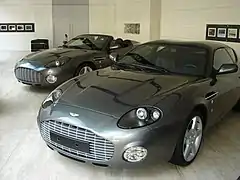


- 1922: Fiat 501
- 1922: Diatto Tipo 25 4DS
- 1925: Lancia Lambda
- 1929: Alfa Romeo 6C 1500
- 1929: Alfa Romeo 6C 1750 GS
- 1930: Alfa Romeo 6C 1750 GS Testa Fissa
- 1932: Alfa Romeo 6C 1750
- 1932: Alfa Romeo 8C 2300
- 1937: Alfa Romeo 8C 2900
- 1938: Fiat 1500 Spider MM
- 1938: Fiat 500 Siata
- 1938: Lancia Aprilia Sport MM
- 1938: Lancia Aprilia Sport Aerodinamica
- 1947: Fiat 500 B Panoramica
- 1947: Isotta Fraschini 8C Monterosa
- 1948: Ferrari 166 MM Panoramica
- 1949: Maserati A6 1500 Panoramica
- 1952: Fiat 500 CZ
- 1952: Fiat 8V Elaborata
- 1953: Osca 4500 Biondetti
- 1954: Maserati A6 G/54 2000
- 1955: Alfa Romeo 1900C SS Zagato Coupe
- 1956: Fiat Abarth 750 GT
- 1958: AC Ace-Bristol Zagato
- 1957: Alfa Romeo Giulietta SZ
- 1957: Jaguar XK 140 Z
- 1957: Lancia Appia GT
- 1958: Lancia Flaminia Sport
- 1960: Fiat Abarth 1000
- 1960: Aston Martin DB4 GT Zagato
- 1960: Bristol 406
- 1961: Bristol 407
- 1962: 1960 Osca 1600 GTZ
- 1962: Alfa Romeo 2600 Sprint Zagato
- 1962: Lancia Flaminia Tubolare
- 1962: Lancia Flavia Sport
- 1963: Alfa Romeo Giulia TZ
- 1964: Lancia Flaminia Super Sport
- 1965: Alfa Romeo Gran Sport Quattroruote
- 1965: Lamborghini 3500 GTZ
- 1966: Lancia Fulvia Sport
- 1967: Lancia Flavia Super Sport[11]
- 1967: Shelby Zagato
- 1969: Alfa Romeo GT Junior Zagato
- 1969: Volvo GTZ
- 1970: Cadillac Eldorado NART
- 1972: Iso Varedo
- 1972: Zagato Aster Coupe
- 1974: Zagato Zele 1000
- 1975: Bristol 412
- 1976: Lancia Beta Spider (Designed by Pininfarina, Zagato Produced)
- 1984: Maserati Biturbo Spider
- 1986: Aston Martin V8 Zagato
- 1988: Autech Stelvio
- 1989: Alfa Romeo SZ
- 1991: Ferrari 348 Elaborazione
- 1991: Nissan Gavia
- 1992: Alfa Romeo RZ
- 1992: Lancia Hyena
- 1992: Fiat 500 Z-ECO
- 1993: F.I.V.E Formula Junior Elettrosolare
- 1993: Zagato Ferrari FZ93 (Renamed ES1)
- 1993: Autech Gavia
- 1996: Fiat Bravobis
- 1996: Zagato Raptor
- 1997: Lamborghini Canto
- 2001: Alfa Romeo 147 Concept Zagato
- 2002: Alfa Romeo 147 GTA.Z
- 2002: Aston Martin DB7 Zagato
- 2003: Aston Martin DB AR1
- 2004: Aston Martin Vanquish Zagato Roadster
- 2004: Lancia Fulvia Sport Concept
- 2005: Lancia Ypsilon Sport
- 2006: Ferrari 575 GTZ
- 2006: Toyota Harrier Zagato
- 2007: Maserati GS Zagato
- 2007: Ferrari 599 GTZ Nibbio[12]
- 2008: Spyker C12 Zagato
- 2008: Bentley Zagato GTZ
- 2008: Diatto Ottovù Zagato
- 2008: Perana Z-One
- 2009: Ferrari 550 GTZ Roadster
- 2010: Alfa Romeo TZ3 Corsa
- 2011: Fiat 500 Coupe
- 2011: Alfa Romeo TZ3 Stradale
- 2011: Aston Martin V12 Zagato
- 2012: AC 378 GT Zagato
- 2012: BMW Zagato Coupe
- 2012: BMW Zagato Roadster
- 2013: Aston Martin DBS Coupe Zagato Centennial
- 2013: Aston Martin DB9 Spyder Zagato Centennial
- 2013: Porsche Carrera GTZ
- 2014: Lamborghini 5-95 Zagato
- 2014: Aston Martin Virage Zagato Shooting Brake
- 2015: Thunder Power Sedan
- 2015: Zagato Maserati Mostro
- 2016: Aston Martin Vanquish Zagato
- 2016: MV Agusta F4Z
- 2017: IsoRivolta Zagato Vision Gran Turismo
- 2017: Aston Martin Vanquish Zagato Volante
- 2018: Aston Martin Vanquish Zagato Speedster
- 2018: Aston Martin Vanquish Zagato Shooting Brake
- 2020: Aston Martin DBS GT Zagato Centenary[13]
- 2020: IsoRivolta GTZ[14]
Notable designers
- Ugo Zagato
- Luigi Rapi
- Ercole Spada
- Giuseppe Mittino
- Norihiko Harada
See also
- List of Italian companies
Notes
- Zagato. Masterpieces of styles - L. Greggio 2017
- Enciclopedia dei carrozzieri italiani - A. Sannia 2017
- "The Fiat 1400, as interpreted by coachbuilders". hemmings.com. Retrieved 1 July 2019.
- "Zagato's Fiat-Abarth 1000 Record Monza". italianways.com. Retrieved 28 October 2020.
- Zagato Milano 1919-2014 - AA.VV. 2014
- Enciclopedia dei carrozzieri italiani - A. Sannia 2017
- Zagato. Masterpieces of styles - L. Greggio 2017
- Zagato Cento 1919-2019 - AA.VV. 2019
- Zagato Milano 1919-2014 - AA.VV. 2014
- Zagato Cento 1919-2019 - AA.VV. 2019
- "1967 ZAGATO LANCIA FLAVIA SUPER SPORT PROTOTIPO". archivioprototipi.it (in Italian). Retrieved 17 December 2019.
- "Car For Sale: Rare 2007 Ferarri 599 GTZ Nibbio Zagato". topspeed.com. Retrieved 28 October 2020.
- "Aston Martin DBS GT Zagato Centenary teased". evo.co.uk. evo.co.uk. Retrieved 26 March 2019.
- "Zagato presents the GTZ: the car which marks the rebirth of IsoRivolta brand". zagato.it. zagato.it. Retrieved 8 August 2020.
External links
| Wikimedia Commons has media related to Zagato. |
- http://www.zagato.it/
- Coachbuild.com encyclopedia: Zagato
- https://www.flickr.com/groups/zagato/pool/
- https://web.archive.org/web/20090227085303/http://www.zagato-cars.co.uk/ Broughtons Zagato Ambassador UK
- Elio Zagato - Daily Telegraph obituary
